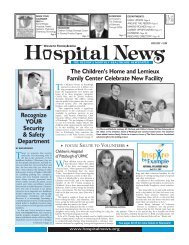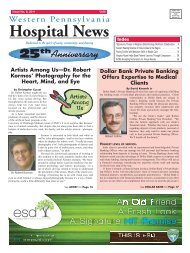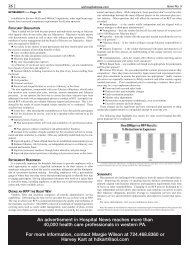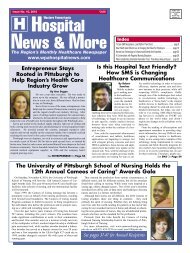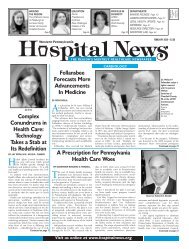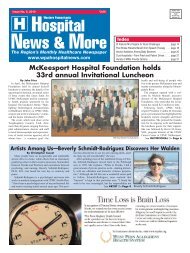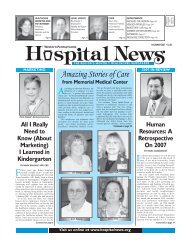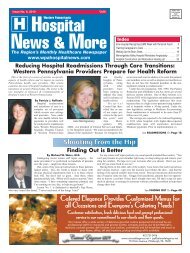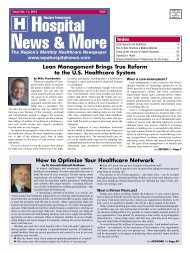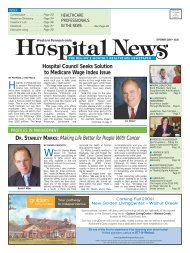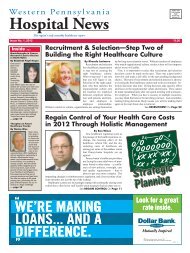Hospital News, 10-1-2011 - Western Pennsylvania Healthcare News
Hospital News, 10-1-2011 - Western Pennsylvania Healthcare News
Hospital News, 10-1-2011 - Western Pennsylvania Healthcare News
Create successful ePaper yourself
Turn your PDF publications into a flip-book with our unique Google optimized e-Paper software.
Issue No. <strong>10</strong> wphospitalnews.com| 13Tomorrow’s Organ Transplants: A Farewell to Wait Lists andImmune Rejection?By David GreenMore than <strong>10</strong>0,000 Americans are currently on the activewaiting list for an organ transplant. Meanwhile, theaverage annual cost of immunosuppressive drugs—takenafter a transplant to keep the body from rejecting the neworgan—is more than $11,000, and in some instances canbe as much as $25,000, according to the American Societyof Transplant Surgeons.These stark figures are motivating a quest within thebiomedical research community for innovation. “One ofthe most promising avenues of approach is the developmentof techniques for growing an organ from a patient’sown stem cells,” says David Green, President of Holliston, MA-based Harvard Bioscience.“In so doing, we eliminate the long wait time that might be required forthe patient to receive a suitable organ, and do away with the need for immunosuppressivemedications following the procedure.”A significant success in this area was recently achieved with the company’s help.At Karolinska University <strong>Hospital</strong> in Huddinge, Stockholm, Sweden, a 36-year-oldman suffering from late-stage tracheal cancer was recently provided with a new tracheathat was grown in the laboratory, seeded by the patient’s own stem cells. Theoperation was performed by Professor Paolo Macchiarini of Karolinska University<strong>Hospital</strong> and Karolinska Institutet, along with colleagues including Prof. AlexanderSeifalian from University College in London, England.Despite maximum treatment with radiation therapy, the patient’s tumor hadreached approximately six centimeters in length and was extending to the mainbronchus. It was progressing and almost completely blocked the trachea. Since nosuitable donor windpipe was available, the transplantation of the synthetic tissueengineeredtrachea was performed as the last possible option for the patient, referredby Professor Tomas Gudbjartsson of Landspitali University <strong>Hospital</strong> (Iceland), whowas also part of the surgical team.This represents the first time a synthetic organ has ever been successfully transplantedinto a patient. The key technology behind the surgery was a shoebox-sizedapparatus known as a bioreactor, created by Harvard Bioscience, in which the newtrachea was grown. The bioreactor was loaded with a nanocomposite “scaffold,”designed and built by Prof. Seifalian, and made out of a porous plastic polymer material,in the shape of the patient’s original trachea. Over the course of about twodays, the scaffold was rotated inside the bioreactor while its surface was soakedwith stem cells taken from a bone marrow biopsy from the man’s hip.Over that two-day period, the patient’s stem cells settled into the pores inside thescaffold, and started to grow into each other, gradually transforming from individualcells into real tissue. A few days after the new trachea was implanted, the patient’sown blood vessels actually began to grow into it, making the new organ truly a partof his own body. Because the patient’s own stem cells were used, the patient’s bodyaccepted the transplant without the use of immunosuppressive drugs. The patientwas subsequently discharged from the hospital and is doing well.What does tomorrow hold for this type of bioreactor technology? For the immediatefuture, explains David Green, Harvard Bioscience’s president, the scaffoldapproach to generating synthetic body parts will be limited to tubular organs suchas trachea and blood vessels, rather than more complex organs such as kidneys andlivers. However, other types of organs may become a practical option in time. “Ibelieve the future will witness the widespread adoption of this technique for trachealcancer patients, who number about 1,800 annually,” Mr. Green says. “Beyond that,it is possible that the technique can be applied to other tubular organs like esophagus,blood vessels and ureters.”Should this scenario unfold as some predict, it could spell the dawn of a new erain the treatment of thousands of patients whose lives and health will be significantlyimproved.David Green is President of Holliston, MA-based Harvard Bioscience, a global developer,manufacturer and marketer of a broad range of specialized products, primarilyapparatus and scientific instruments, used to advance life science researchand regenerative medicine. He can be reached at dgreen@harvardbioscience.com.ADVANCE YOUR CAREERWITH A MASTER OF SCIENCE, HEALTH SCIENCESDo you want to be better positioned toadvance your career in the clinical arena,research or administration?As the only Planetree Designatedfacility in <strong>Pennsylvania</strong>, we focus onservice excellence and personalizedcare for patients and their families.Are you seeking to better understand theevolving healthcare industry as well as thefuture of healthcare in the United States?Enhance your career by earning yourMaster of Science, Health Sciencesentirely online from Duquesne University.This 30-credit program features:Online accelerated 7-week courseswith no required campus visitsHighly experienced faculty withadvanced degrees in public health,education and business administrationCompetitively priced tuitionYou Have A Choice. Choose...For complete information visit:www.duq.edu/advanceQuestions?Contact hsms@duq.edu orcall 412.396.1602What Health Care Should Be.600 Somerset Ave., Windber(814) 467-3000www.windbercare.org



